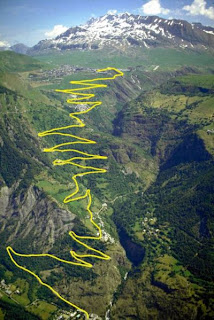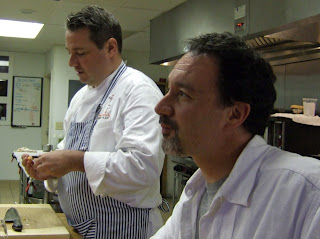Like the concept of a chef’s tasting menu itself, the “with wine pairings” option has its detractors. Those who aren’t fans feel that you’re likely to end up with leftovers in both scenarios. There’s a certain way to avoid the potential pitfalls of at least the first of these two scenarios. Restaurants that offer nothing but a tasting menu are sure to put their best effort and ingredients into your plates. Wine pairings, though, can still be hit or miss. You’re at the mercy of the sommelier (or lack thereof). Pairings can be thoughtful, even inspired or, on the flipside, downright dismal.
Is there a workaround for the wine trap? Sure, though depending on where you are it may narrow your options: choose a spot with a BYO policy. The wine list is yours to make. If the pairings flop, there’s only you, and maybe a little bad luck, to blame. A full-on BYO policy, meaning one with no corkage fee, is a major bonus. Take as few or as many bottles as you’d like. I tend to err on the side of plenty. If you’re going to eat eight dishes over the course of an entire evening, why not try a wine with each? When a few friends and I headed out for
dinner at Talula’s Table last week, we did just that.
 Mosel Riesling QbA trocken, Freiherr von Heddesdorff 2006
Mosel Riesling QbA trocken, Freiherr von Heddesdorff 2006This was the first bottle to hit the table, instantly becoming our de facto aperitif. Von Heddesdorff’s basic QbA’s may not win awards for complexity but they make for an inexpensive and fairly solid introduction to the world of trocken and halbtrocken German Riesling. Though still lean, this was a good deal less austere than when last tasted and carried a refreshing little trace of CO2. Clean, minerally and simple – in a good way.
$14.50. 12.5% alcohol. Cork. Importer: Petit Pois, Moorestown, NJ. “La Cravantine,” Domaine Fabrice Gasnier NV
“La Cravantine,” Domaine Fabrice Gasnier NVThis we paired with our first course, snapper crudo, as the idea of bubbly with just a whisper of rose to its color seemed tailor made for the pink hues and cool textures of the dish. If you missed the AOC designation in the wine name, that’s because there isn’t one. Fabrice Gasnier’s estate is located in Chinon, an AOC district that allows for red, white and rosé but not bubbly. Fabrice makes “La Cravantine” anyway. It’s a Blanc de Noir bubbly, made entirely from Cabernet Franc. And though it’s not vintage dated, it is a single-year wine, this lot being from 2007. A tad softer in acidity and, arguably, a bit simpler than the last couple of versions, its raspberry and floral nuances still make it pretty darn tasty. And it worked, though it’s one of those wines that will work with just about anything.
$22. 12% alcohol. Cork. Importer: Petit Pois, Moorestown, NJ. Muscadet de Sèvre et Maine Sur Lie “Clos des Allées” Vieilles Vignes, Domaine de la Grange (Pierre Luneau-Papin) 2005
Muscadet de Sèvre et Maine Sur Lie “Clos des Allées” Vieilles Vignes, Domaine de la Grange (Pierre Luneau-Papin) 2005Pure mineral springs. There’s a limestone and saline quality at play, but really, really subtle. Crisp up front and surprisingly creamy on the finish. A very pretty wine, one that asks you to tune in rather than shouting for attention. This was one of my favorite pairings of the night, matched to a buttery lobster and summer squash tart. A bigger, richer white would have blown the delicacy of the lobster out of the water.
$14. 12% alcohol. Cork. Importer: Louis/Dressner, New York, NY. Viré-Clessé “Vieilles Vignes,” Domaine André Bonhomme 2004
Viré-Clessé “Vieilles Vignes,” Domaine André Bonhomme 2004This is in a really good place right now. Smelling it, at least initially, reminds me of fresh, dry dirt, kicked up in the infield of a baseball diamond. Bonhomme’s ‘04s were initially a little plump but this has clearly shed some fat and taken on a greater depth of minerality since last tasted. Hallmark to his wines, there’s a creamy core of yellow peach fruit and a taut finishing grip. This wine and the next were sampled back and forth with two dishes: a mushroom, goat cheese and corn “papusa” and a tartine of smoked sable. No match was spot-on but both wines provided points of interest with each dish.
$30. 13.5% alcohol. Cork. Importer: Petit Pois, Moorestown, NJ. Brda Chardonnay, Movia 2000
Brda Chardonnay, Movia 2000I was surprised when my good blog-fellow Jeremy Parzen recently mentioned that he’d never noticed the oak influence in Movia’s wines. I say that because I’ve yet to taste a wine from Movia where an oak influence wasn’t present and detectable. What I like about Movia’s wines, though, is that they’re not o-a-k-y. Instead, the oak is integrated, eaten up by and at one with the wine. As
Dr. J points out in his excellent post, that’s a good thing, exactly the intention of Movia winemaker Aleš Kristančič. I’m not sure this was a perfect bottle (it was picked up at risk, a back vintage at closeout pricing at a local PLCB shop). Run-up on the cork suggested the likelihood of some heat damage, as did a slight disjoint in the wine’s alcohol profile. Nonetheless, it came alive with the food, applying a fine balance between muscle, acidity and mellow fruit, in spite of its tarnished condition. There’s a more in-depth tasting of Aleš’ wines lurking somewhere in my future.
$16. 13.5% alcohol. Cork. Importer: Domaine Select Wine Estates, New York, NY. Burgenland Zweigelt, Paul Achs 2006
Burgenland Zweigelt, Paul Achs 2006I first had Paul Achs’ Zweigelt at a restaurant in Vienna a couple of years back. My memories of it were fond and this bottle didn’t disappoint. Achs makes real Zweigelt. Not oaked up or adorned with an international gloss, it’s chunky, spicy and exuberant. Think of loganberry and blueberry fruit and a dash of cinnamon along with a meaty rusticity, good acidity and just enough tannin to make your mouth water. This bottle was a bit short on the finish but that’s my only complaint. A solid match, it echoed and complemented the gaminess of the barbecued squab with which it was served.
$26. 12.5% alcohol. Cork. Importer: Vin DiVino, Chicago, IL. Crozes-Hermitage, Domaine Combier 2000
Crozes-Hermitage, Domaine Combier 2000In spite of the Italianate nature of the final savory course of the evening, the thought of beef tortellini with fresh tomato sauce and fried eggplant somehow cried out to me for Syrah. I’ve written up Laurent Combier’s wines before,
here and
here, but it was only in the 2000 vintage that I laid them down in any quantity. This bottle not only reminded me of why but made me wish there was more left. Heady scents of olives, macerated red berries, cedar and spice. Impeccable balance. The kind of wine that tends to raise eyebrows and result in scratched heads because it’s so different from what many people anticipate. As my instincts told me to expect, it was great with the food. (PS: I preferred Combier’s old label design.)
$20 on release. 12.5% alcohol. Cork. Importer: Petit Pois, Moorestown, NJ. Sancerre, Domaine du Carrou (Dominique Roger) 2007
Sancerre, Domaine du Carrou (Dominique Roger) 2007At this point, I suppose we could probably have gone back to the other open bottles for some small tastes to accompany the cheese course. But there it was, a bottle of Sancerre, just asking to be opened. Sauvignon Blanc does offer versatility with cheese, after all. Dominique Roger produces, year in and year out, a pretty straightforward example of Sancerre from Bué, crisp, limestone-driven, relatively elegant and without any of the catty or clumsy characteristics that SB often packs as unwanted baggage. His ’07 is light, fruity and typical. A touch meek for many of the evening’s cheese selections but refreshing nonetheless.
$25. 13% alcohol. Cork. Importer: Petit Pois, Moorestown, NJ. Moscato d’Asti, G. D. Vajra 2005
Moscato d’Asti, G. D. Vajra 2005The combination of fizziness and loads of residual sugar makes it easy for Moscato based stickies to mask flaws. When they’re done right, though, as Aldo Vajra’s always are, they can be downright delicious. It makes sense, as Aldo farms biodynamically and harvests pristine fruit. And his winemaking staff watches the Moscato non-stop during its short fermentation cycle to ensure that everything is just right. Common wisdom suggests that Moscato d’Asti should be drunk as young as possible. While I don’t disagree, this bottle was still quite good, even after getting lost in my cellar for the last two years. The intense floral and grapey characteristics inherent in its youth had morphed into a rounder, subtler creature. Yet it was still undeniably good. When in doubt, if actually pairing with sweet thereafters, there’s no more versatile “dessert wine.”
$16 on release. 5.5% alcohol. Cork. Importer: Petit Pois, Moorestown, NJ. “Nocino,” Fattoria Cescana
“Nocino,” Fattoria CescanaOne of my dining companions, Natale Caccamo, makes a homebrew of sorts, a digestivo he calls “Nocino.” Based on organic green walnuts, along with a proprietary list of herbs and aromatics (a little bird told me that espresso, clove, orange peel and cinnamon may play a role), it put just the right finishing touch on a great meal and a slew of good wines, enjoyed among friends.
70 proof.
Intro only...
 The market is anchored by fresh fruit and vegetable growers such as Blooming Glen Farm (above) and Weavers Way (below).
The market is anchored by fresh fruit and vegetable growers such as Blooming Glen Farm (above) and Weavers Way (below).
 Headhouse gains depth from the range and diversity of its many small, specialty producers, such as Yoder Heirlooms (above) and Culton Organics. I'm pretty sure that's Tom Culton sportin' the straw cap in the photo below but please correct me if I'm wrong. My note taking was nonexistent, so I'm working on memory cells here.
Headhouse gains depth from the range and diversity of its many small, specialty producers, such as Yoder Heirlooms (above) and Culton Organics. I'm pretty sure that's Tom Culton sportin' the straw cap in the photo below but please correct me if I'm wrong. My note taking was nonexistent, so I'm working on memory cells here.
 Spring Hills Farm is another of the market's specialty producers. Emily (pictured above) worked the market all day selling wool and maple syrup, two of the primary products (along with Xmas trees) harvested on her family's property in Dalton, PA.
Spring Hills Farm is another of the market's specialty producers. Emily (pictured above) worked the market all day selling wool and maple syrup, two of the primary products (along with Xmas trees) harvested on her family's property in Dalton, PA.

 A shot of the market crowd as the ring of the closing bell approached.
A shot of the market crowd as the ring of the closing bell approached.






















































